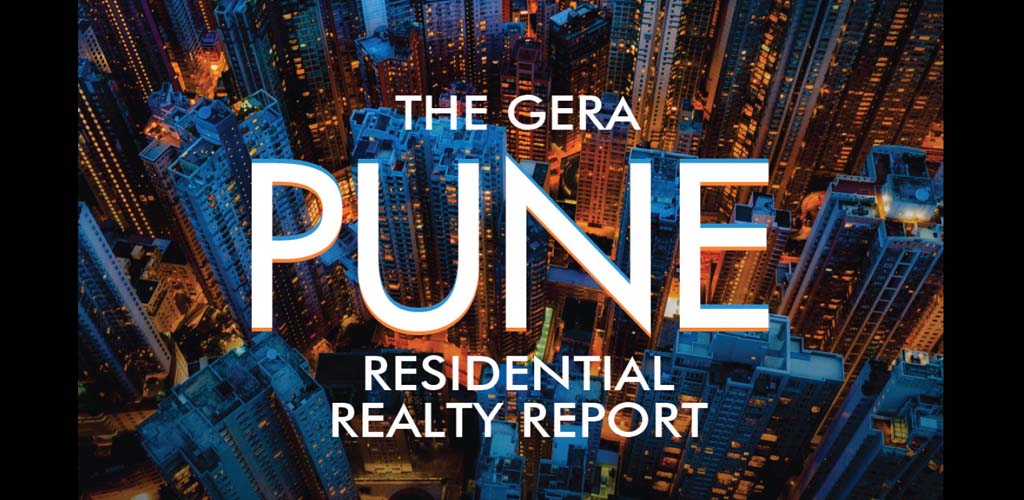Pune Residential Realty Report: Sales back to pre-COVID levels, Affordability at an all-time high leading to rising prices and increase in share of top developers

Pune, January 6, 2021: Gera Developments, pioneers of the real estate business and the award-winning creators of premium residential and commercial projects in Pune, Goa, and Bengaluru, today released the January 2021 edition of their bi-annual report, The Gera Pune Residential Realty Report.
This longest-running, census-based study of the Pune Residential Realty Market in India is based on primary & proprietary research conducted by Gera Developments and covers all existing projects in a 30 Km radius of the city center.
The performance of the residential realty sector in 2020 has been strongly impacted by the Covid-19 pandemic and consequent lockdowns which brought activities in the industry to a standstill. Further, developers also dealt with labour shortages and incurred additional costs in light of the migrant crisis. However, despite the lockdown, the Pune residential real estate market seems to have climbed a wall of worry and has posted very encouraging numbers across the board.
The impact is evident across all parameters. Sales are back to normal and are at par with pre-COVID levels. Average prices across the city have risen by 3.5%. Inventory is the lowest in six years in both, absolute and percentage terms. Total number of projects have fallen by 15% compared to five years ago, and number of new units launched has fallen by 40%, which was expected. In the same period, projects launched in the premium plus (between Rs 5,721 & Rs 7,151 psf) and luxury (above Rs. 7,151 psf) segments increased.
Key Highlights of the report:
- Overall increase in prices by 3.5%.
As compared to 2019, prices have increased by 3.5% in 2020. This rise is driven by a steep increase of 17.29% in the prices of new projects during the pandemic year. Within new projects, homes with larger number of bedrooms, especially 3BHK, have seen their prices increase, which has further contributed to the rising prices.
- Affordability is at an all-time high
Affordability for home buyers is at its highest in nine years, needing a 3.68x salary to buy a 1000 sq. ft. home. The index was marginally high at 3.79 in Jun ’20 and dipped to 3.68 by Dec ’20. This has empowered more buyers to go to bigger developers and demand more quality, instead of approaching smaller developers in a fragmented market. This shift from many small developers to few big developers is leading to market consolidation.
- Sales growth is back to pre-COVID levels
The 6-monthly sales numbers for the July to Dec ’20 period is at 44,709 units while in the same period last year, the number was 45,110. This indicates that beyond a negligible decrease, sales figures are back to pre-COVID levels. While overall sales in 2020 have dropped by 12.34% compared to 2019, the drop has been largely confined to H1 2020, while H2 2020 has registered a recovery. Sales have barely been impacted in the 800+ sq.ft. segment and have actually increased by 24% in the 1,201 – 1,400 sq.ft. segment.
- Market share of Top Developers continues to increase
The research considered the top 20 developers in Pune in terms of brand name and repute. To ensure consistency and uniform comparison, the report has maintained the same list of developers over the past 5 years and then calculated what was their share in the last 12 months. The top 20 developers account for more than 1/5th of the sales volume seen in 2020.
- Steep fall in total number of live projects
Total number of live projects being built has fallen significantly to 3,046 in Dec ’20 from 3,630 as on Dec ’16. This 16% drop in number of projects however has seen a reduction in the total inventory by only about 3%. The average number of apartments per project therefore has risen from about 90 homes per project to about 103 homes per project.
As of Dec ’20, the total number of projects on hold (where work has commenced and presently stopped) has reached 292 (the figure of 3,046 live projects excludes these 292 projects). These 292 projects consist of a total of 44,206 apartments. 26,341 have been sold. Some of these are stuck since before the introduction or RERA, while others have got stuck on account of the various challenges faced by the real estate sector over the years.
- New launches fall by 41%
New launches have fallen from 99,541 units in 2019 to 59,078 units in 2020, registering a drop of 41%. This, however, was expected and especially showed up in the first half of 2020 when the new launches dropped by over 50%. The second half of 2020 however also saw a drop of over 27% compared to H2 2019.
The luxury segment has reduced launches by just under 25% whereas surprisingly, the budget and value segment have seen a drop of between 44% and 46% in the new inventory launched in 2020.
- Demand is greater than Supply
The Covid-19 pandemic and ensuing lockdowns severely impacted activities and supply side in the residential realty sector. As a result, the replacement ratio (which is the new supply added divided by the number of apartments sold in a period of time) plummeted sharply to 0.55 in Jun ’20 before rising to 0.85 in Dec ’20. In other words, demand exceeded supply significantly in H1 2020 as sales picked up at the individual customer level but project launches by developers was deferred in the face of uncertainty. With new inventory coming in, the replacement ratio has risen to 0.85.
While releasing the report, Mr. Rohit Gera, Managing Director, Gera Developments said, “The year 2020, especially the first half, was a tough time for the residential realty sector. Seismic events have a tendency to change market dynamics and the pandemic and lockdown is no different. New launches crashed in the first half of the year on account of the pandemic. However, in the second half, new launches somewhat recovered, the bounce back of sentiment reflected in sales in the second half of 2020 being almost the same as the same period of 2019. The introduction of lesser new inventory though, has led to unsold inventory in number of units being at a 6-year low. Affordability is up by about 50% in the past 6 years. Increased affordability and reduced availability are a classical set up for prices to start rising.
Normally, this would be considered the beginning of a price rise cycle, however, developers are ready to bring in new supply. This is compounded with the new development control rules that have been recently introduced by the State government where development potential has increased substantially and hence developers are back to the drawing board to redesign their projects – we expect that the same number of new projects will contain a lot more inventory in the near future.
We therefore expect that the short-term shortage of supply will lead to a price rise followed by a period of stability in prices on account of increasing inventory being brought into the market.”
Mr. Gera further cautioned, “As always, we continue to advise home buyers to be careful of where to buy. It is very easy to get carried away in a rising market. This is especially the time to ensure that the developer they are buying from is financially strong, the project has financial closure and is adequately capitalized to ensure the project does not suffer on account of a cash crunch.”
CONCLUSION
The entire year of 2020 can be categorized into two halves, H1 2020 in which the residential realty sector bore full brunt of the consequences of the pandemic and the lockdowns, and H2 2020 in which it bounced back and is on the path of the recovery. Owing to the rise in inventory, prices, new launches and sales numbers in H2 2020, we can say that the market has put behind the uncertainty posed by the Covid-19 situation.
However, competitive intensity amongst the top tier developers has increased. 7.5% of all the live projects account for ~36% of the offtake and more than 1/5th of the offtake is accounted for by the top 20 developers.
Affordability has brought about a structural change in the market landscape with customers now opting for higher bedroom types with top-tier developers.
Some developers with the desire to match customer aspirations have started pushing the envelope to attain clear undisputable market leadership.
About the Gera Pune Residential Realty Report:
The Gera Pune Residential Realty Report is a bi-annual initiative by Gera Developments that is aimed at garnering insights on both the supply and demand sides of the residential realty market in Pune. This census-based study uses feet on street methodology of data gathering and covers the Pune Urban Agglomeration area. The data is then validated and statistically analysed. What started, as a knowledge gathering initiative in 2011 has now become something that realtors, IPCs, Research Houses, Brokerage Houses and Banks & Financial Institutions look forward to. Besides a broad overview on inventory available, offtakes and prices, the report dives deeper to mine insights by price segment, sq. footage, construction stage and size of unit.





